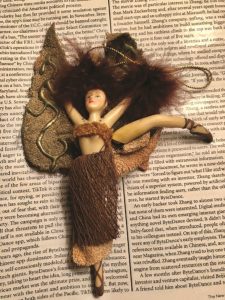OK, the holidays are over. We made it to the new year, Christmas is almost two weeks behind us, and we are all done with it: like a way-too-sweet piece of chocolate enjoyed immensely but now almost too painful to contemplate. The tree is looking old and grizzled, and the decorations grate on the nerves. But I want to return to that festive holiday to explore a phenomenon that occurs in our family.

Picture a large and lovely balsam tree in your home, adorned with pretty twinkling lights — and a collection of the ugliest ornaments known to humankind. Among them: a severed horse’s head with an unbearably cheerful grin; a frizzy-haired ballerina with leathery bat-like wings and one of her legs dislocated out of an arm socket; a bare-chested overweight Santa lounging in a tropical cabana; another Santa who appears to have been in a terrible accident; a stack of drunken Santa heads; an ornately framed ultrasound of somebody (titled “best gift ever!”); and quite a few more.
Actually, these are not (yet) hanging on a tree but lined up on a table at my in-laws’ Truro house, each to be judged on the degree of its horribleness. This yearly ritual has been going on in our extended family since our daughter and her husband started it almost a decade ago. Virtually the entire family participates, ages 6 to 84, each selecting an ornament to enter in the contest (except me: I’m just no good at it). There are no set criteria other than that the ornaments must be store-bought and intended as Christmas decorations. The entries are made anonymously; the judges are my nephew and his wife, who come down from Maine for this and other aspects of the holiday.
This tradition brings to my mind the notion of aesthetics and the varying perspectives that people bring to the concept of beauty — and its opposite. Consider that these ghastly trinkets were purposely designed (probably in America) and manufactured (certainly in China) and meant to be purchased for holiday ornamentation. Nobody was trying to make a statement; they were trying to make a buck.
Consider, too, that every item purchased was imagined and created by someone with some sense of its worth. Where does this sense come from? Are there universal standards? It is hard to imagine someone looking at a centaur with a Santa’s head as something beautiful. Looking at a severed grinning horse’s head: was it meant to be grotesque or did we uncover a hidden quality in the psyche of the creator or the buyer? Who in their “right mind” came up with or bought such a thing?
Of course, we must consider the notion of camp — that is, creating something to be ironic, absurd, or exaggerated, deliberately silly — mocking, in this case, the sacred Christmas holiday. In one sense, irony is a form of protection, a defense against caring too much; someone can “make fun” of the holiday while still celebrating it.
So, is this a form of ridicule of the whole Christmas scene: too much sweetness and light, carols and bunting and mistletoe? Maybe. At the same time, my family members have their eyes out for that perfect ugly ornament all year long as they tread the aisles of T.J. Maxx, Marine Specialties, Snow’s, and various thrift shops and yard sales. That means they are actually thinking about Christmas in July.
There is also the aspect of sharing. Yes, that bizarre leathery-winged ballerina might be offensive and creepy, cringeworthy even, or just a bit tacky and tasteless; but its presenter is bringing you her perspective, asking you to be in on the joke, and thereby creating a bond.
And then there’s one more thing: fun. There is nothing like the shared laughter of a gathering of family and friends. That ugly ballerina (the winner) brought us joy.



